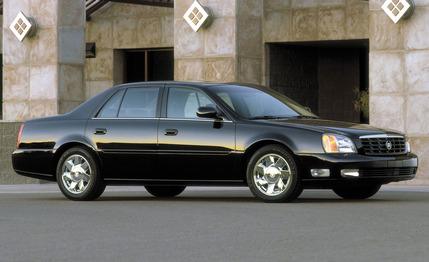 First Drive Review
First Drive Review
For Cadillac to introduce a new model at a racetrack seems about as natural as Hillary Clinton kicking off her U.S. Senate campaign by addressing a convention of the National Rifle Association. Yet there we were at Phoenix International Raceway, getting tips on braking and turn-in points before a hot-lap session. What's more, the subject of our cornering ministrations wasn't a hotted-up Catera, or an STS, or the exotic Evoq. We were evaluating the latest incarnation of that most baroque of luxury sedans, the DeVille.
To our shock and amazement, the most sporting version of this new DeVille, called the DTS--for "DeVille Touring Sedan"--did more than merely survive this trial by tire. It was astonishingly composed and capable, by any standard.
Braking hard into a corner produced none of the expected outside-front-tire howling as the rubber was overloaded by the combined effects of load transfer, body roll, and braking force. Accelerating hard out of a corner was similarly undramatic--there was no spinning of the inside wheel, nor much understeer from the outside front tire that was bearing so much of the cornering and tractive loads. Even in a variety of slalom tests, the front-drive, two-ton, 207-inch-long DTS responded accurately to our steering inputs with little extraneous wallowing or porpoising. A Lexus LS400 was provided for comparison purposes, and it felt notably sloppier and less willing in the same strenuous maneuvers.
Credit the big Caddy's new-found athleticism to the third-generation G-body platform, which this 2000 model employs, and also to the electronic magic performed by the latest generation of Cadillac's StabiliTrak active-handling system. It now coordinates seamlessly with the newest version of Cadillac's continuously variable road-sensing suspension (CVRSS).
For these 2000 models, the CVRSS uses a newly designed shock absorber that not only varies the damping rate in tiny steps over a wide range in 0.2 second but also varies it independently for compression and rebound. Previous versions of CVRSS could only alter the damping in both directions simultaneously. In combination with the DTS's vehicle speed, steering angle, suspension travel, and lateral-acceleration sensors, this more sophisticated shock-absorber adjustability allows the CVRSS to better tailor the suspension's performance to road conditions.
By coupling this greater suspension proficiency with the StabiliTrak system, Cadillac engineers have improved handling under all conditions. As with previous StabiliTrak systems, the brake on one of the front wheels is applied to reduce extreme understeer or oversteer. But now the CVRSS can also selectively stiffen or soften the extension or rebound tendencies of any shock absorber to help keep the body on an even keel and better balance the car well before the cornering limit is reached.
For example, by stiffening the compression damping of the outside front tire and tightening the rebound damping of the inside rear tire while braking into a corner, the DeVille avoids the sudden compression of the outside front suspension, preserving the geometry of that critical tire. It sounds like black magic, but the systems work perfectly to keep the DTS responsive to the driver's inputs and facilitate smooth driving.
All the credit can't go to the electronic wizardry, however, because the base DeVille and the DeVille High Luxury Sedan (a.k.a. DHS, it replaces the d'Elegance model) come with neither StabiliTrak nor CVRSS, yet their road manners are also quite capable. Those manners result from the new G-body platform, which has received numerous upgrades since its debut six years ago on the Oldsmobile Aurora. As applied to the DeVille, the platform gets several reinforcements to increase stiffness and crash protection, as well as a wheelbase extension of 1.5 inches to increase rear seating space.
Underneath, the basic suspension geometry used on all G-platforms is carried over, with rubber-isolated subframes front and rear. But the control arms locating the front struts, as well as the semi-trailing arms in the rear suspension, are now made of aluminum, rather than steel, to reduce weight. That rear suspension has a whopping 10 inches of total travel along with load leveling to maintain a constant ride height regardless of how many bodies you put in the back seat or in the trunk. GM's MagnaSteer rack-and-pinion system directs the front wheels and adjusts steering effort based on vehicle speed (and the lateral-acceleration sensor on the DTS).